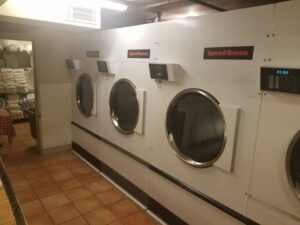DISCOVERING THE SCIENCE OF COMMERCIAL DRYERS

For sure, it is more than likely that a commercial dryer service like a laundromat is located somewhere in your neighborhood. However, the knowledge of how these machines work is not known to many. To satisfy everyone’s curiosity, let’s go through the fascinating processes of turning your soaking wet clothes dry and ready to be pressed and worn!
How Does a Commercial Dryer Work?
In learning how things work, you will get to have a renewed appreciation of these simple things. The next time you go to your trusted commercial dryer service, you’re going to get a whole new perspective on the art and process of clothes drying process.
So how do dryers do their job? In a nutshell, clothes dryers work their magic by following the science of evaporation. They turn the liquid water that runs within the threads of your clothes in vapor or gas and then they get rid of it.
Simple, isn’t it? However, there’s an entire process that goes through this simple appliance. After all, understanding how things work is all about learning the specifics. These appliances bring together a combination of heat, air, and motion to effectively remove moisture and dry your clothes.
Heat Production
Heat mainly speeds up the drying process for your clothes. With either electricity, propane, or natural gas, dryers power up the heating element similar to the ones used in water heaters or ovens. Modern dryers mainly use electricity to make this happen.
Once enough heat is present, a blower distributes the heated air throughout the inside of the dryers and on to the wet laundry. Thermal fuses, as well as thermostats, are present to regulate temperature and prevent the appliance from overheating and damage the clothes–or worse, cause fires.
Air Circulation
Just like how the breeze helps clothes dry quickly on a clothesline, dryers use heated air circulation to remove all the remaining moisture from the clothes. Through the vents or openings, heated air goes around with the help of a blower or a fan. The process repeats itself until the clothes dry up and are ready.
During the cycle, fresh air also comes through the vent as the moisture exits from the back of the dryer and out of it. Therefore, it’s important to check if the appliance comes with proper venting to avoid blockages that will disrupt the smooth process of drying the fabrics.
Motion Control
Everything goes into motion with the dryer drum. It efficiently tumbles the clothes as it is an essential component in properly drying the fabrics. Without it, the clothes will pile up and not allow the presence of proper air circulation.
The drums turn in a specific direction through a simple pulley that works with an electric motor that powers it up. In this setup, the drum sits in what is known as a roller system which gets its support from an axle.
Modern clothes dryers still work with all these components. They also come with specific functions which add to their features. One good example here is a steam dryer. This appliance helps remove wrinkles and strong odors that reside in the fabric.
All in all, this is how your laundromat’s trusted commercial dryer service effectively dries your clothes and makes them ready to wear. Indeed, it’s a specific process that makes the magic happen down to a science.
Wash IQ offers laundry machine maintenance, installation and repair services in: Alameda County, Alpine County, Amador County, Butte County, Calaveras County, Colusa County, Contra Costa County, Del Norte County, El Dorado County, Fresno County, Glenn County, Humboldt County, Imperial County, Inyo County, Kern County, Kings County, Lake County, Lassen County, Los Angeles County, Madera County, Marin County, Mariposa County, Mendocino County, Merced County, Modoc County, Mono County, Monterey County, Napa County, Nevada County, Orange County, Placer County, Plumas County, Riverside County, Sacramento County, San Benito County, San Bernardino County, San Diego County, City and County of San Francisco, San Joaquin County, San Luis Obispo County, San Mateo County, Santa Barbara County, Santa Clara County, Santa Cruz County, Shasta County, Sierra County, Siskiyou County, Solano County, Sonoma County, Stanislaus County, Sutter County, Tehama County, Trinity County, Tulare County, Tuolumne County, Ventura County, Yolo County, Yuba County

